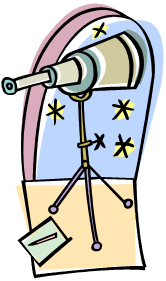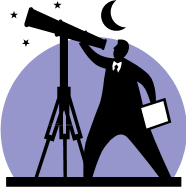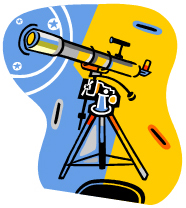Star Party Etiquette
Rules of the Road!
 Star parties are a lot of fun, both for the seasoned observer and the newcomer. Most star party veterans love to show off their gear, talk about astronomy and answer questions. However, a few things about observing the night sky may not occur to first-time star partygoers.
Star parties are a lot of fun, both for the seasoned observer and the newcomer. Most star party veterans love to show off their gear, talk about astronomy and answer questions. However, a few things about observing the night sky may not occur to first-time star partygoers.
 First, certain safety rules are important. It is easy to become disoriented in the dark and wander into an accident. Second, telescopes are expensive, and a certain amount of care is required around them. Third, nighttime observing and photography require total darkness. Bright lights destroy night vision and are definitely a no-no. Astronomers use red flashlights, which do not compromise night vision.
First, certain safety rules are important. It is easy to become disoriented in the dark and wander into an accident. Second, telescopes are expensive, and a certain amount of care is required around them. Third, nighttime observing and photography require total darkness. Bright lights destroy night vision and are definitely a no-no. Astronomers use red flashlights, which do not compromise night vision.
Having said the above, the night sky is beautiful, and the rules of etiquette aren’t meant to stifle enthusiasm but rather to ensure that everyone has a safe and pleasant experience while enabling others to enjoy the same. With that in mind, here are the rules of the road — most of which is just common sense and courtesy!
stifle enthusiasm but rather to ensure that everyone has a safe and pleasant experience while enabling others to enjoy the same. With that in mind, here are the rules of the road — most of which is just common sense and courtesy!
Preparation
- Bring warm clothes. The air cools quickly after dark, even after a warm day. Astronomy is sedentary and there’s no movement to generate warmth. Bring layers for weather 15 degrees cooler than the forecast.
- If you plan an extended stay you may decide to bring a light snack and a beverage. However, please observe the rule below about not eating or carrying drinks near telescopes.
- Bring your own equipment if you wish. Make a checklist of items such as star charts, batteries, tools, etc. If you need help setting up, ask; most veterans will be glad to help once their setup is complete.
- Leave flashlights at home or place a red filter over the lens (see advice on lights below). Many astronomical objects are very faint, and it takes 30 minutes for eyes to adapt to night vision.
Safety
- Watch your step in the dark, especially around tripods, chairs, tables and other equipment. Watch for wires on the ground and other obstacles. If your scope requires power make the wires as safe as possible.
- Green lasers are popular because they project a collimated beam into the sky, allowing astronomers to point out stars and constellations to onlookers. However, never point a laser at anyone or anything, especially not an airplane. In fact, the latter is illegal; lasers can momentarily blind or disorient the pilot.
- Never look at the sun through a telescope unless it is properly filtered to protect your eyes. Amplifying the sun through a telescope, binoculars, or other instruments will instantly damage your eyes and can cause irreversible blindness. Use only specially designed solar filters under the watchful eye of an expert astronomer. If RAC is observing the sun, we will have the proper equipment and can show you how it works.
Arriving and Departing
- Arrive before dark so your headlights won’t interfere with night vision — or use parking lights if safe to do so. Park so that you won’t have to use backup lights as you leave. If you plan to leave the park early near the exit.
- Drive slowly, for safety and to avoid kicking up dust.
- Plan to arrive before sunset if you have the equipment to set up. The time when the sun sets and daylight changes slowly to full darkness is a beautiful time to observe. You get to see how the colors change and which objects in the sky are the first to become visible.
- If you arrive without a telescope leave parking space near the telescopes for those with equipment.
- Turn off your car’s interior lights. Most cars have a dial or switch (often connected to the panel light dimmer) that shuts off interior lights even with open doors. Pulling up a notch or two on the parking brake of some cars with automatic headlights turns off interior lights.
- Use parking lights to exit telescope field if safe to do so; turn on headlights as soon as you think necessary for safety. Driving without any lights is unsafe!
- Be courteous to the owner of the place you observe. If there is a gate at the telescope location, it is the responsibility of the last person to leave to close it!
Red Lights Only
- Darkness is essential for viewing faint objects. Don’t use white light sources such as flashlights or car headlights. Dark adaptation takes 30 minutes and white light reverses the eye’s dark adaptation very quickly.
- Astronomers use red flashlights to read charts and books because they do not reverse night vision. If you do not have a red flashlight cover a regular flashlight with red plastic secured with a rubber band.
- If you must use a white light ask first; someone may be in the midst of a long exposure photography session.
- Flash photography is strictly a no-no. Photos can be taken during equipment setup, prior to full darkness.
- Stray light from laptop computers can be dimmed with a red plastic sheet.
Asking Questions
- If you have questions, ask; most astronomers are more than willing to share with you whatever they know.
- Setting up complex equipment requires dedicated concentration. Allow those thus engaged to complete their tasks without distraction. The sooner the gear is aligned, the sooner the show can begin
- Respect astronomers who want to work on their own or who are engaged in activity requiring complete concentration. While public sessions are usually very social, a few have personal observing programs.
Observing Through Telescopes
- Put down anything you are holding before looking into a telescope. Some scopes have open frames with exposed primary mirrors. One slip can damage an expensive mirror!
- Queue up and wait for a turn to look through a particular telescope. After your view, move to another scope. After making the rounds, go back to the first scope as something new may be in view.
- Ask where the focuser is located so you can adjust it for your eyes. Don’t grasp the eyepiece to steady yourself. It may cause loss of calibration or even damage the mount’s mechanical components.
- Owners of large scopes provide a stepladder for viewing comfort. Take care to keep your balance while on the ladder. Assist small children so that they do not lose their balance or grab the scope to steady themselves.
Noise, Music, and Conduct
- Avoid loud and boisterous behavior. The same restraint applies to shouting, running, racing car engines and other forms of noise making. Star-gazing is a quiet, tranquil activity.
- Leave your music at home or wear a headset. The music you love may be extremely irritating to others.
- Generators are not allowed at some star parties. RAC does allow them if they are quiet.
Children and Pets
- Children are welcome — an early observing experience can kindle a lifetime love of astronomy. All of RAC’s public events are family-friendly. But make sure your child understands the rules about safety, not touching the equipment and noisy or disruptive behavior.
- All children must be accompanied by a parent or other responsible adult. We are not able to provide childcare. Please do not drop off children at a star party. If you are arriving for a Scout or other youth event, please wait for the group leaders to arrive. They are responsible for your child, not RAC.
- Supervise small children at all times. Since the telescope field is dark small children are more likely to trip and hurt themselves, become lost, or bump into and damage expensive equipment.
- Toddlers are too young to understand how to look into the telescope. When lifted, their natural tendency is to grab the telescope. Let them have their turn when they are old enough to look for themselves without help.
- Make sure pets are under control at all times. Frisky behavior is cute, but it can be disastrous around expensive equipment.
Food, Drink and Spray Cans
- Do not use aerosol sprays on the observing field, including insect repellent, hairspray, etc. These sprays can permanently damage telescope optics. Lotions or roll-ons are fine.
- Don’t carry food and drink around the scopes. Spills are a serious problem for telescopes, accessories and computer controllers.
- Pick up your trash. Many star parties are held on public property, and your litter may cause officials to disinvite the astronomers next time.
- Alcohol is usually prohibited at public locations. It adversely affects night vision, body temperature and ability to drive home in the dark. And all too often it leads imbibers to ignore the “loud and boisterous behavior” rule.
- Refrain from smoking near telescopes. Smoke particles adhere to and damage telescope optics. If you must smoke, please move well away from the telescope area.
 Having said all that, star parties are great fun and the views can be nothing short of thrilling on a good night. Come on out and enjoy!
Having said all that, star parties are great fun and the views can be nothing short of thrilling on a good night. Come on out and enjoy!
P.S. The above rules are mostly common sense and courtesy. In fact, they are a synthesis of write-ups found on many astronomy websites. So if some of the words look familiar that may be because they are!
